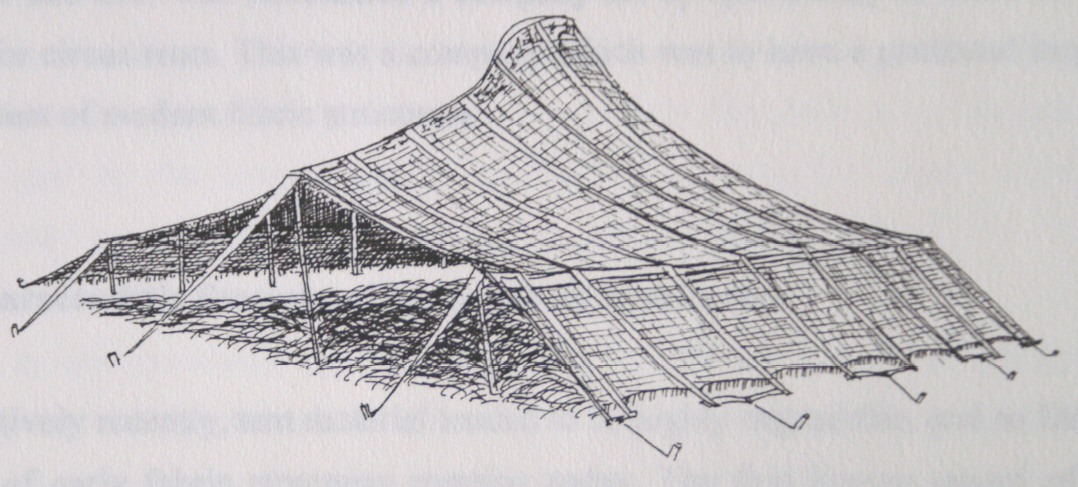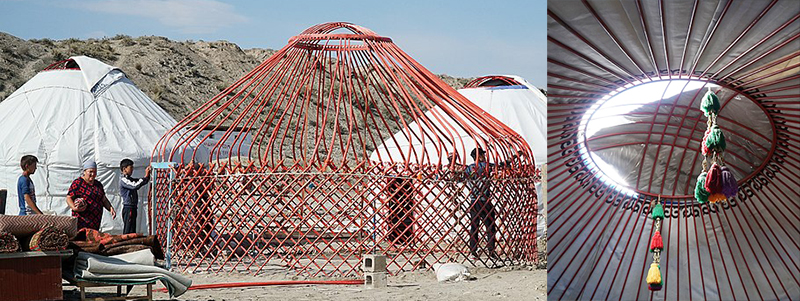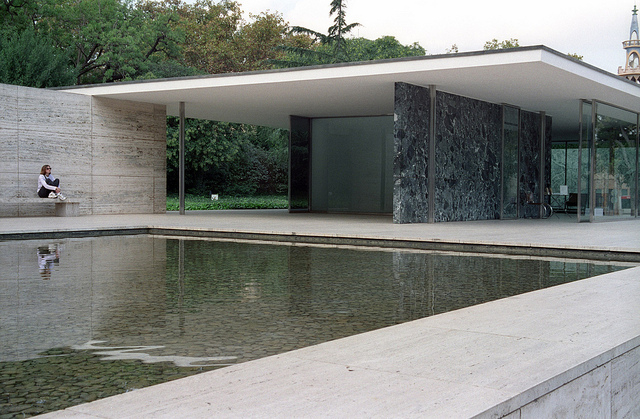The history of buildings

|

|

|

|
Contents |
[edit] Introduction
Buildings have played a significant role in human civilization, reflecting the cultural and social values of different eras, providing shelter and security and adopting and developing technological advancements.
[edit] Ancient architecture
The history of buildings can be traced back to the earliest human civilizations, where people constructed simple structures using natural materials such as wood, animal skins, stone, and clay. These early dwellings were primarily designed to provide shelter and protection from the elements, with little emphasis on aesthetics.
For more information see: Shelter.
However, they quickly developed and became more ornate and complex, with particular styles emerging in different areas depending on the availability of materials, environmental conditions, functional needs, cultural traditions and so on.
One of the most significant examples of ancient architecture is the Great Pyramid of Giza in Egypt. This monumental structure, built over 4,500 years ago, is a testament to the ingenuity and engineering skills of the ancient Egyptians. The pyramid, which stands over 480 feet tall, was constructed using millions of limestone blocks, each weighing several tons. The pyramid was built as a tomb for pharaohs and their consorts, and was intended to protect their bodies and souls for eternity.
Another example of ancient architecture is the Parthenon in Athens, Greece, built over 2,400 years ago. This temple, dedicated to the goddess Athena, served as the centre of religious and political life in ancient Athens. The Parthenon is renowned for its beautiful architecture and intricate sculptures, which continue to inspire artists and architects to this day.
For more information see: Classical architecture.
[edit] Medieval architecture
During the medieval period, architecture underwent a significant transformation, as new building techniques and materials were developed. Gothic architecture, characterised by its soaring spires, pointed arches, and intricate stone carvings, emerged in France in the 12th century.
One of the most famous examples of Gothic architecture is Notre-Dame Cathedral in Paris, which was built in the 12th and 13th centuries. This stunning cathedral features beautiful stained glass windows, soaring vaulted ceilings, and a towering spire that reaches over 400 feet into the sky. Notre-Dame Cathedral remains one of the most iconic landmarks of Paris and attracts millions of visitors every year.
For more information see: Gothic architecture.
Another significant development in medieval architecture was the construction of castles and fortresses, which served as defensive structures against enemy attacks. One of the most famous examples of a medieval castle is the Tower of London, built in the 11th century by William the Conqueror. The tower has served various purposes throughout history, including as a royal palace, a prison, and a treasury.
For more information see: Medieval architecture.
[edit] Renaissance architecture
During the Renaissance period, architecture underwent another major transformation, as architects began to look back to the classical styles of ancient Greece and Rome for inspiration. Renaissance architecture was characterised by its symmetrical proportions, classical columns, and ornate decoration.
One of the most famous examples of Renaissance architecture is the Palazzo Vecchio in Florence, Italy. This impressive palace, built in the 14th century, served as the seat of government for the city of Florence. The palace features beautiful frescoes, ornate ceilings, and a stunning clock tower that overlooks the city.
Another notable example of Renaissance architecture is St. Peter's Basilica in Vatican City. This iconic structure, designed by Michelangelo, is the largest church in the world and serves as the centre of the Roman Catholic Church. The basilica features a grand dome, towering columns, and beautiful artwork by some of the most renowned artists of the Renaissance period.
For more information see: Renaissance architecture.
[edit] Modern architecture
In the 20th century, architecture underwent another major transformation, as new materials and technologies allowed for the construction of taller and more complex buildings. Modern architecture is characterised by its emphasis on functionality, minimalism, and the use of materials such as steel, concrete, and glass.
One of the most famous examples of modern architecture is the Empire State Building in New York City. Completed in 1931, this iconic skyscraper was the tallest building in the world at the time of its completion, standing at over 1,400 feet tall. The building is renowned for its Art Deco style and has become a symbol of New York City and American architecture.
Another notable example of modern architecture is the Sydney Opera House in Australia. This iconic building, designed by Danish architect Jørn Utzon, is characterised by its distinctive sail-like roofs and has become one of the most recognizable buildings in the world. The Opera House serves as a cultural centre for the city of Sydney and attracts millions of visitors every year.
For more information see: Modern architecture.
[edit] Contemporary architecture
In recent years, architecture has continued to evolve, with architects experimenting with new materials, technologies, and design concepts. Contemporary architecture places an emphasis on sustainability, innovation, and the use of digital tools and techniques.
For example, the Burj Khalifa in Dubai, United Arab Emirates, completed in 2010, is a towering skyscraper stands at over 2,700 feet tall, making it the tallest building in the world. It features a unique design that blends Islamic and contemporary architectural styles, and it serves as a symbol of Dubai's modernisation and economic growth.
Another example of contemporary architecture is the Heydar Aliyev Center in Baku, Azerbaijan. Designed by architect Zaha Hadid, the centre has flowing curves and an organic forms and serves as a cultural centre for the city of Baku.
[edit] Conclusion
The history of buildings is a testament to human creativity, ingenuity, and innovation. From the simple dwellings of our ancient ancestors to the towering skyscrapers of today, architecture has evolved in response to changing cultural, social, and technological trends. The buildings of the past continue to inspire and captivate us, while the buildings of the present and future push the boundaries of what is possible.
[edit] Related articles on Designing Buildings
- Architectural design.
- Architectural styles.
- Art Deco.
- Arts and craft movement.
- Bauhaus.
- Brutalism.
- Building Construction in Britain from 600AD to 1890.
- De Stijl.
- English architectural stylistic periods.
- High-tech architecture.
- International Style.
- Medieval architecture.
- Modernist architecture.
- Nineteenth century architecture.
- Postmodern architecture.
- Shelter.
- Types of building.
- Vernacular architecture.
Featured articles and news
RTPI leader to become new CIOB Chief Executive Officer
Dr Victoria Hills MRTPI, FICE to take over after Caroline Gumble’s departure.
Social and affordable housing, a long term plan for delivery
The “Delivering a Decade of Renewal for Social and Affordable Housing” strategy sets out future path.
A change to adoptive architecture
Effects of global weather warming on architectural detailing, material choice and human interaction.
The proposed publicly owned and backed subsidiary of Homes England, to facilitate new homes.
How big is the problem and what can we do to mitigate the effects?
Overheating guidance and tools for building designers
A number of cool guides to help with the heat.
The UK's Modern Industrial Strategy: A 10 year plan
Previous consultation criticism, current key elements and general support with some persisting reservations.
Building Safety Regulator reforms
New roles, new staff and a new fast track service pave the way for a single construction regulator.
Architectural Technologist CPDs and Communications
CIAT CPD… and how you can do it!
Cooling centres and cool spaces
Managing extreme heat in cities by directing the public to places for heat stress relief and water sources.
Winter gardens: A brief history and warm variations
Extending the season with glass in different forms and terms.
Restoring Great Yarmouth's Winter Gardens
Transforming one of the least sustainable constructions imaginable.
Construction Skills Mission Board launch sector drive
Newly formed government and industry collaboration set strategy for recruiting an additional 100,000 construction workers a year.
New Architects Code comes into effect in September 2025
ARB Architects Code of Conduct and Practice available with ongoing consultation regarding guidance.
Welsh Skills Body (Medr) launches ambitious plan
The new skills body brings together funding and regulation of tertiary education and research for the devolved nation.
Paul Gandy FCIOB announced as next CIOB President
Former Tilbury Douglas CEO takes helm.
UK Infrastructure: A 10 Year Strategy. In brief with reactions
With the National Infrastructure and Service Transformation Authority (NISTA).























Comments
[edit] To make a comment about this article, or to suggest changes, click 'Add a comment' above. Separate your comments from any existing comments by inserting a horizontal line.